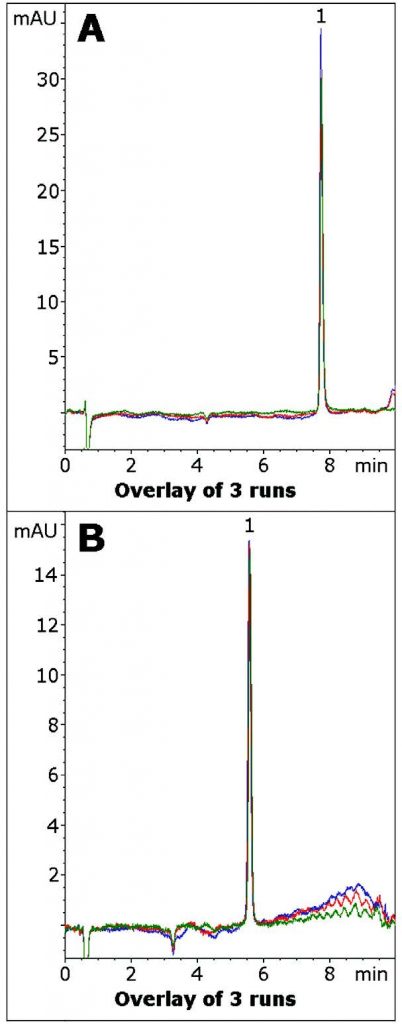Benefits of using 2.2 µm column for Vancomycin analysis
The highly polar antibiotic Vancomycin can be readily analyzed with either the standard 4µm Cogent Diamond Hydride or the Cogent Diamond Hydride 2.o column. Notably higher efficiency is obtained on the smaller particle size column.
This Method is easy to perform and is LCMS compatible. Three runs were performed on each column in order to demonstrate consistency and show the benefits of using the smaller particle column.


Peak:
Vancomycin
Method Conditions
Columns:
—Fig. A: Cogent Diamond Hydride 2.o™, 2.2µm, 120Å
—Fig. B: Cogent Diamond Hydride™, 4µm, 100Å
Catalog Nos.:
—Fig. A: 70200-05P-2;
—Fig. B: 70000-05P-3
Dimensions:
—Fig. A: 2.1 x 50 mm
—Fig. B: 3.0 x 50 mm
Mobile Phase:
—A: DI Water / 0.1% Formic Acid (v/v)
—B: Acetonitrile / 0.1% Formic Acid (v/v)
| Time (minutes) | %B |
| 0 | 70 |
| 0.4 | 70 |
| 7.4 | 10 |
| 8.4 | 70 |
Post time: 5 minutes
Injection vol.: 0.2 µL
Flow rate:
—Fig. A: 0.29 mL / minutes
—Fig. B: 0.50 mL / minutes
Detection: UV @ 210 nm
Sample:
–Stock Solution: 1 mg / mL Vancomycin HCl in 50 / 50 solvent A / solvent B diluent. The solution
–was filtered through a 0.45µm Nylon Syringe Filter (MicroSolv Tech Corp.).
–Working Solution: Stock solution was diluted 1:100 with 50/50 solvent A/ solvent B mixture.
t0: 0.4 minutes
Note: Vancomycin is a glycosylated non-ribosomal Peptide antibiotic used to treat Colitis. Vancomycin is often used as a drug of last resort when other antibiotics are rendered ineffective due to developed resistance of bacteria. It is a natural product isolated from Amycolatopsis Orientalis.
Attachment
Vancomycin Method Transfer pdf Download File


